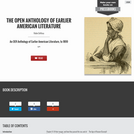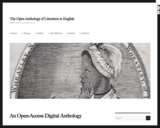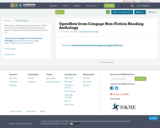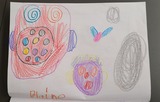
An OER Anthology of Earlier American Literature to 1899
- Subject:
- Arts and Humanities
- English Language Arts
- Reading Literature
- Material Type:
- Primary Source
- Textbook
- Provider:
- Pressbooks
- Author:
- Robin DeRosa
- Date Added:
- 11/08/2015

An OER Anthology of Earlier American Literature to 1899

This is an anthology in progress of literature in English. It is designed to be a transatlantic anthology, with examples of texts written in the British Isles, but also colonial America, wand the United States. Many of the texts have been freshly edited and annotated to provide authoritative and curated editions for the use of students and general readers, and to create an alternative to expensive print anthologies. Over time, all of these texts (and more) will be edited and annotated to use the full resources enabled by the digitization of literary works. Please feel free to comment on these texts; we hope to improve the anthology based on the needs of readers.
The anthology is designed to work well on desktop and laptop computers, but also mobile devices like tablets and smartphones. We include the hypothes.is plug-in, which allows readers to add their own layer of annotation to the texts–to underscore key passages, add notes, ask questions. Go to www.hypothes.is for more information on how the plug-in works.
This is very much a work in progress. Some texts have been edited and annotated fully; others partially; others not at all. Author biographies are being drafted; material is being added. Keep checking back for updates.
This project is open-access, and the texts are available for anyone to use as they wish. We also invite others to join in the project by editing and annotating texts of their own, which can be incorporated in the site to create a free, open-access anthology of reliable works for use in the classroom.

An Anthology and Guide
Short Description:
A guide for students of early British Literature from the 8th to 18th centuries.
Word Count: 1254623
(Note: This resource's metadata has been created automatically by reformatting and/or combining the information that the author initially provided as part of a bulk import process.)

Non-fiction reading anthology appropriate for college-level introductory English courses: Developmental English / Integrated Reading & Writing, English Comp I & II.

Reading anthology to accompany college-level introductory English courses: Developmental English / Integrated Reading & Writing, English Comp I & II.

In this professional learning we will explore some amazing resources! There are FREE texbooks and ebooks available for downloading!

Because Shakespeare’s works were meant to be performed, students will be introduced to Shakespeare’s language in general and the plot and themes specifically of Othello through props and looking at specific language use (insults, negative connotation words). This is the second day in a longer unit. This lesson was created by Kristi Bose and is designed for Grade 9 English Language Arts students. Each student will make predictions about the plot and themes of the play. This Remote Learning Plan addresses the following NDE Standard: NE LA 10.1.5c, NE LA 10.1.5e, NE LA 10.1.6i and NE LA 10.1.6n.

This is the third day in a longer unit. Students will use two informational texts two analyze the theme of racism, especially in the context of interracial marriage and apply those concepts to Act I, Scene i of Othello. This lesson was created by Kristi Bose and is designed for Grade 9 English Language Arts students. Each student will analyze the theme of racism in Othello as a starting point for a discussion about racism in today’s society. This Remote Learning Plan addresses the following NDE Standard: NE LA 10.1.5d, NE LA 10.1.6d, 10.1.6i, 10.1.6.n, and NE LA 10.1.6o.

Because Shakespeare’s works were meant to be performed, students will be introduced to Shakespeare’s language in general and the plot and themes specifically of Othello through quoting lines. This is an introduction to a longer unit. This lesson was created by Kristi Bose and is designed for Grade 9 English Language Arts students. Each student will memorize one key quote from Othello, build background knowledge about Shakespeare’s language including iambic pentameter, and make predictions about the plot and themes of the play. This lesson plan addresses the following NDE Standard: NE LA 10.1.5c, NE LA 10.1.5e, and NE LA 10.1.6l.Approximate time: 50 minutes

(Version: 18 Aug 2019)
Short Description:
Migration of the William Kirmse and Henry Lohman families from Perry County, Missouri to Alva, Oklahoma.
Long Description:
How the William Kirmse and Henry Lohman families homesteaded on the western edge of the The Cherokee Strip among a colony of Volga German Russians near Goodwin, Oklahoma Territory. Their abodes, family, and harvesting of crops as well as descriptive stories of their Volga German Russian neighbors are presented. And, a photo tour of the Goodwin area a century is provided a century after the Kirmses and Lohmanns moved to Alva, Oklahoma
This is book is a work in progress. The comment boxes will be open during the development of this book. If you find errors or have suggestions, please use the comment box at the end of each chapter. All comments will be appreciated that help improve this book.
If you have related pictures and stories about Out-Migration From Perry County To Oklahoma, please send copies to Family.Kirmse@gmail.com so that they can be included.
Word Count: 23259
(Note: This resource's metadata has been created automatically by reformatting and/or combining the information that the author initially provided as part of a bulk import process.)

Short Description:
This book is an educational, entertaining, and highly personal memoir written during a global pandemic. It provides an insightful snapshot of the occasionally bumpy yet spiritually transformative cancer journey of a middle-aged, immigrant, and non-partnered academic living in a sunny Canadian prairie province.
Long Description:
This book is an educational, entertaining, and highly personal memoir written during a global pandemic. It provides an insightful snapshot of the occasionally bumpy yet spiritually transformative cancer journey of a middle-aged, immigrant, and non-partnered academic living in a sunny Canadian prairie province.
It will be of interest to anyone who: 1) is or has been on the cancer continuum as a patient, caregiver, family member, or friend; 2) is or strives to be a health professional (oncologist, GP, nurse, social worker, pharmacist, physio- or exercise therapist, etc.); 3) is an administrator, instructor, teaching assistant, or student at a post-secondary institution interested in health sciences, English literature (memoir writing, creative non-fiction, and narratives of illness), Women’s and Gender Studies, Spirituality Studies, Religious Studies, and the Fine Arts; 4) fellow authors and/or readers who like to give writers from the Canadian prairies a chance.
The Appendix includes “Leading Reading Questions” meant to increase everyone’s reading experience and lighten the load of fellow university professors who wish to adopt this book, or part of this book, for a class.
Word Count: 53928
ISBN: 978-0-7731-0764-9
(Note: This resource's metadata has been created automatically by reformatting and/or combining the information that the author initially provided as part of a bulk import process.)

Within this collection you will find lessons, videos, handouts, and teacher guides you can use in your classroom. You will also find a brief summary of each resource with the source sited for further exploration, appropriate grade level, approximate lesson length, and learning standards.

The following resources are aids to help you understand and dive deeper into John Steinbeck's novel, The Pearl. The resources to the right are learnings aids and a Check Your Understanding Assessment. The video includes audio and more information on the Presentation. However, if you missed something, you can go back through the slides at your own pace. The student worksheet can be used as a check your understanding or notes while the student watches the videos or as an assessment to check understanding. The teacher answer key has answers to the student worksheet.Clicking View will allow you to view the slide on Google slides, the video on Vimeo, and the worksheets in Google Docs. Simply make copies of the Student Worksheet by going File, Make a copy, inside Google Docs, if students are filling out online. Otherwise, simply print the document as is. Created by a high student, for high school students.

Short Description:
"Penser les passages dans les littératures et cultures africaines" se veut l’aboutissement de réflexions critiques autour d’une esthétique qui sans être nouvelle, connaît d’heureuses et éclairées interprétations. Les passages convoquent inéluctablement les théoriciennes et théoriciens du roman dont Bertrand Westphal et Mikhaïl Bakhtine et avec eux des considérations géocritiques et chronotopiques. Les auteurs et autrices des études proposées manient avec une grande originalité l’application de ces théories aux textes et aux contextes spécifiquement africains. La notion de passage dans cette perspective permet d’en appréhender la fécondité dans les littératures et les cultures africaines. Les contributions lèvent le voile sur les tendances générales des champs littéraires ou sur les poétiques particulières pour étudier des passages de nature esthétique et formelle, culturelle et ritualisée. Dans la diversité des propos, ce sont les manifestations de ces passages marquant les sociétés africaines qui affleurent, qu’elles soient de nature esthétique, politique, sociale ou culturelle. Les transitions, heureuses ou malheureuses, issues des champs des réalités africaines trouvent donc leur écho critique dans les pratiques d’écriture qui sous-tendent les réflexions de cet ouvrage.
Long Description:
Penser les passages dans les littératures et cultures africaines se veut l’aboutissement de réflexions critiques autour d’une esthétique qui sans être nouvelle, connaît d’heureuses et éclairées interprétations. Les passages convoquent inéluctablement les théoriciennes et théoriciens du roman dont Bertrand Westphal et Mikhaïl Bakhtine et avec eux des considérations géocritiques et chronotopiques. Les auteurs et autrices des études proposées manient avec une grande originalité l’application de ces théories aux textes et aux contextes spécifiquement africains.
La notion de passage dans cette perspective permet d’en appréhender la fécondité dans les littératures et les cultures africaines. Les contributions lèvent le voile sur les tendances générales des champs littéraires ou sur les poétiques particulières pour étudier des passages de nature esthétique et formelle, culturelle et ritualisée.
Dans la diversité des propos, ce sont les manifestations de ces passages marquant les sociétés africaines qui affleurent, qu’elles soient de nature esthétique, politique, sociale ou culturelle. Les transitions, heureuses ou malheureuses, issues des champs des réalités africaines trouvent donc leur écho critique dans les pratiques d’écriture qui sous-tendent les réflexions de cet ouvrage.
Word Count: 60145
ISBN: 978-2-924661-73-4
(Note: This resource's metadata has been created automatically by reformatting and/or combining the information that the author initially provided as part of a bulk import process.)

This Learning Plan was created by Tessie Boudreau as part of the 2020 NDE OER Project. The attached Remote Learning Plan is designed for Grade 6 English Language Arts students. Students will understand the components of a book review and real life application. Students will draft and publish their own book review using persuasive writing techniques. This Remote Learning Plan addresses the following NDE Standard: NE LA It is expected that this Unit Plan will take students 1-2 weeks to complete.

Lessons focused around The Dot, Ish, Sky Color, Happy Dreamer, and The Word Collector.Links to readings of the books.Examples of artwork and class books.This lesson could lead to an author study.

Short Description:
The Picture of Dorian Gray (1891) is a philosophical novel by Irish playwright Oscar Wilde; it is his only novel. The story centre's on Dorian Gray, the subject of a full-length portrait in oil by Basil Hallward, an artist impressed and infatuated by Dorian's beauty. Through Basil, Dorian meets Lord Henry Wotton, an aristocrat who teaches him that beauty and sensual fulfilment are the only things worth pursuing in life.
Long Description:
The Picture of Dorian Gray (1891) is a philosophical novel by Irish playwright Oscar Wilde; it is his only novel. The story centre’s on Dorian Gray, the subject of a full-length portrait in oil by Basil Hallward, an artist impressed and infatuated by Dorian’s beauty. Through Basil, Dorian meets Lord Henry Wotton, an aristocrat who teaches him that beauty and sensual fulfilment are the only things worth pursuing in life.
Word Count: 79792
(Note: This resource's metadata has been created automatically by reformatting and/or combining the information that the author initially provided as part of a bulk import process.)

After reading Playing for Change, students will have the opportunity to break into groups and do research about various subgroups and topics provided in the text. The intention is for this to be a jigsaw activity where groups can organize their information with the interactive notebook sheets provided, and then present or share with the class what they have learned. Teachers can use this for language arts or social studies assessments, if needed.

When reading a narrative, there are some key story elements to pay close attention to. The two we are focusing on in this seminar are setting and plot. You will be able to describe in depth the setting and the plot using specific details from the text. First, you will be applying past knowledge to help you identify the parts of a plot as well as the setting. Using a graphic organizer, you will be listening to audiobooks and filling in these five elements of exposition, rising action, climax, falling action, and resolution. By looking closely at a story, you are learning how a story is written and how important these parts are.StandardsCC.1.3.4.C Describe in depth a character, setting or event in a story or drama, drawing on specific details in the text.

In this lesson, students will be introduced to Edgar Allan Poe's theory on the “single effect” of the short story. They will read a passage from Poe as well as his short story “The Tell-Tale Heart.”Students will annotate the text to look for how the author uses Gothic elements to set a mood in the environment (the "single effect") and the changes or effects it has on the main character (the focus on the individual Poe is known for).